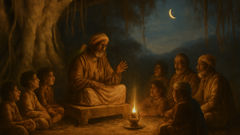Introduction
Beneath the canopy of Indian storytelling, where banyan roots knot like old secrets and village fires keep time by the rhythm of night, there exists a quieter layer of the Jataka corpus—tales that rarely cross the threshold into popular collections but hum with the same ethical gravity as the famous legends. These are stories the Buddha is said to have lived before his final awakening: not grand heroic epics, but intimate parables of restraint, cleverness, reluctant sacrifice and small mercies that shaped the moral imagination of subcontinental folk. This introduction seeks to open a window into those lesser-known lives: the parrot whose loyalty altered a king's judgment, the mendicant who saved a river-bound village with an act of improbable patience, the gardener who refused an easy vengeance and found a dignity that outlived kings. Each tale in this collection is retold with care, preserving the cadence of oral transmission while translating the images and rhythms into prose that carries their cultural resonance into a modern reader's mind. I will trace how these narratives move between moral instruction and human vulnerability—how they were shaped by trade routes, temple theaters, and the domestic hearth—and how their motifs persist inside familiar ideas of justice, forgiveness and wise restraint. This journey is equal parts archaeology of story and intimate encounter: we will listen close to voices that once lived in the shade of stupas and on the lips of storytellers, and through them we will glimpse an ethic of attention that the Jatakas practice across lives.
Tales of Quiet Courage and Clever Mercy
The Jataka tradition often turns on small acts of recognition that reveal a soul's growth across lifetimes. In the first tale I retell here, the central figure is neither a prince nor a goddess but a parrot named Sālapa. He lives in a courtyard garden that belongs to a minor official, a man who has built his fortune on careful deals and exacting favors. The official's household is bustling: a daughter with a quick smile, a sister always grieving a lost love, the official himself who keeps accounts of allegiances like strings of beads. The parrot watches them all in keen silence.

When a drought descends on the town and a rumor of a royal tax audit reaches the official's doorway, a panic rooted in fear takes hold. The official fears losing his position, his land; he fears the shame of an unpaid debt and the gossip of neighbors. In the panic the official contemplates a small but consequential deceit. He had, months ago, been entrusted with a rare amulet on loan by a traveling ascetic: the amulet's provenance had been spoken of in whispers—some said it was a relic from a saintly lineage, others that it held nothing but carved glass. The official could, in a moment of precaution, sell the amulet and pay his obligations. He considers it. The household hums with anxious talk, and the young daughter bursts into tears.
Sālapa the parrot knows the ascetic. Among the rafters the bird had once overheard conversations about honesty and the unspoilable worth of trust. One dawn the parrot takes the amulet from the shelf—no violence, no rattle of breaking glass—only a soft flutter and the cool weight of something chosen. He flies to the courtyard gate where the traveling ascetic, now returning, rests beneath a sunshade. The ascetic's face warms with instant recognition. He kneels to Sālapa and speaks not in anger but in a tone that soothes the parrot's feathers: he sings a few words that restore the memory of the owner who had lent the amulet. It turns out the relic belonged to a poor temple keeper in a neighboring village who had already been shamed for losing it; the ascetic had been trying to find the owner for months.
When the official learns the truth he feels both relief and shame. He had almost sold something that did not truly belong to him and would have deepened a neighbor's ruin. Yet the man, surprised by the parrot's act, cannot simply reframe his motivations as noble; he must confront his fear. The narrative holds no dramatic trial, no judge in a marble hall. Instead it slows and examines the official as he makes a choice that unmakes the small deception: he opens his ledger to his household, explains the temptation, and invites his neighbors to help make good. This act is not purely heroic—it carries costs—but because it is public and vulnerable it alters the official's standing. Trust returns in small measures, neighbors bring barley and labor, and the temple keeper regains an object that had cost him a night's sleep for weeks.
The story's teaching is subtle: Sālapa's action is not a sermon about truth abstracted, but a lens that shows how small honesty can reweave social fabric. The parrot is a witness, an agent who refuses profit for the sake of reputation. His avian vantage likewise creates a moral distance; because he is outside human anxiety, his act reads like reminder rather than rebuke. Jataka tales often use animals to hold up a mirror to human frailty; in this less-common story the bird's fidelity is not spectacle but a quiet bolt of light that relights human decency.
Another tale in this cluster moves water as its central motif rather than feather. Along a river that winds through a cluster of villages, there was once a narrow stone bridge whose parapets had been cracked by flood and footfall. The bridge connected two markets: one where weavers sold indigo-dyed cloth, another where potters traded their wares. A recurring feud over tolls escalated; traders hired brawny messengers, and folk songs turned the bridge into a border. Into this growing anger steps an elderly gardener named Kavin, a man whose life had been tended around roots more than rhetoric. Kavin's garden lay midway between the markets and watered both fields. He found himself convening petty disputes with teacup patience, listening to grievances until the air in the market felt lighter.
When a storm in the monsoon season washed half the bridge away, the markets were cut off. Leaders of each market pointed fingers. Neither side could agree on how to rebuild; each suspected the other of profiteering. In a moment Jataka storytellers prize—the decision that tests a pattern of character—Kavin proposes a bridge built not with paid labor from one side, but with volunteer teams who will share the work and the food. He offers his garden as a midday kitchen and as a place to rest. The townspeople laugh at first; what gardener can lead a civil engineering task? Yet Kavin's patience and small rituals—how he slices a banana with a steady hand, how he tends a sprouting cutting, how he sits quietly while arguments subside—shift the mood.
As the rebuilding begins, stories are traded at the mortar and between bricks: a clay mug lost in a child's laughter; a weaver's memory of a mother who taught her to mend when cloth tore; a potter's admission that he once sold unequal measures to his own brother and never forgave himself. The rebuilding becomes a procession of confession and repair. The new bridge is narrower but stronger: constructed with shared labor and marked by initials carved by each worker. The bridge's parapet bears a small inscription—Kavin's name and an image of a hand offering a sprig of tulsi—an emblem not of hero-worship but of collective care.
Both tales resist theatrical catharsis; they are composed of small decisions that aggregate into moral consequence. The Jataka ethic, as these stories show, privileges the accrual of right action over sudden revelation. There is no miraculous sudden awakening in these narratives. Instead they invite readers to recognize how patience and modest courage accrue into societal repair. They suggest that wisdom is often less an epiphany and more the slow recognition of how our small, daily choices ripple outward.
Retelling these lesser-known stories also exposes how regional concerns seep into narrative form. Where a coastal community might tell a version of the bridge tale that includes fishermen mending nets, an inland retelling emphasizes irrigation and granary fairness. Traders and temple custodians, ascetics and gardeners—each social actor leaves an imprint on the story's moral anatomy. The Jatakas' flexibility is their strength; oral adaptation keeps them alive. As we listen, we sense how each community folds its anxieties and hopes into the tales, so that the same essential lesson—care, honesty, restraint—is tuned to local instruments.
What remains for a modern reader is an invitation to attend. In an age shaped by rapid gains and loud narratives of singular triumph, these quieter Jatakas argue for a slow ethic. The parrot and the gardener do not spark revolutions, but they refashion trust. Their victories are often invisible to official histories, yet they sustain communal life in ways that matter. This section offers those stories not as quaint relics but as active moral maps, usable again by anyone willing to remove their hands from a ledger and put them into the soil of shared work.
History, Ritual, and the Living Thread of Jataka Memory
If the previous section traced narrative practice through two compact parables, here the inquiry widens to consider how these lesser-known Jatakas lived and survived across centuries: on temple thresholds, in puppet-theatre, through pilgrimage hospitality, and in the quiet recitation under lamp-light. The Jataka corpus is not a static archive but a migratory body of story. Its lesser tales exist at the intersection of religion, regional identity and the economics of memory. To understand why some stories become famous and others remain local, we must consider the social ecology of storytelling.

Temples served as repositories and amplifiers. A roadside shrine attracts travelers who bring news, coins and songs. A local priest might adapt a Jataka to explain a temple's founding, reassigning characters to explain how a lineage of donors first endowed the site. In colder, hillier regions the same Jataka may emphasize endurance through winter rather than flood survival. Puppet troupes—the artisans of drama who traveled from village to village—were instrumental in transmitting tales across linguistic boundaries. Their paintings and marionettes could compress a moral into a single gesture: a pulled string, a painted tear. Because puppet-theatre depends on spectacle, troupes favored robust, action-driven tales; subtler stories—those dependent on quiet interiority like the gardener's patience—sometimes stayed within domestic circles, recited by elders in the home. Thus a tale's performative potential affected its diffusion.
Trade networks mattered too. Merchants moving along coastal routes carried not only cloth and spice but idioms and parables. A trader who found a parable useful for negotiating credit might adapt it into his household lore; his children would remember the story with slight changes—more sea-terms, fewer temple metaphors. Over generations, a parable might shed details and acquire others to remain valuable to new listeners. This pattern explains how a Jataka about a river-bridge in one region can morph into a mountain-path tale in another, yet both keep the same ethical core: cooperation redistributes risk.
Ritual practice conscripted memory in another way. Festivals often re-enacted Jataka moments. During a harvest festival a village might stage a scene where a character refuses a grain-hoarding temptation; the re-enactment confers a ritual cleansing on those who watch. Ritual embeds the tale in communal rhythm: the story becomes part of repeated seasonal life and thus more likely to be remembered. But ritual also selects. Large-scale festival cycles emphasize tales that confirm social order or celebrate publicly recognized virtues—generosity, protection of kin, piety. Tales that complicate norms or insist on ambiguous moral outcomes might be recited quietly, their memory maintained by families rather than temples.
This leads to an essential point about moral complexity. Lesser-known Jatakas frequently highlight moral ambivalence. Unlike moral fables that declare a single taxable truth, Jataka parables can stage dilemmas where the right choice is not obvious. A king must choose whether to punish a subordinate who saved the state's grain but did so by breaking a covenant; a mendicant must decide whether to accept hospitality that would expose a secret; a mother may choose between saving her child and serving a stranger in mortal need. These dilemmas teach discernment rather than rote virtue. They encourage listeners to sit longer with questions, cultivating a moral imagination capable of holding multiple claims—justice, mercy, duty—without rushing to simplification.
Linguistic play and metaphor are also crucial. Ancient storytellers used local metaphors to anchor meaning: comparing a moral failing to a termite in a house, a parable about patience to the slow swelling of a river after summer rains. Such idioms anchor the abstract into the sensory world. For modern readers, recognizing these metaphors opens a door into a mode of thought shaped by agrarian cycles, monsoon rhythms and village economies. Reading the Jatakas with attention to their images—mud-scent after rain, the wheel of a cart creaking, the sharp taste of tamarind—returns the tales from prismatic moral diagrams to lived human experience.
Finally, oral tradition shows resilience through adaptation. In modern times, scholars, translators and artists have revived many Jatakas, sometimes smoothing their rough edges for wider audiences. This process is double-edged: translation can give a tale new life but can also domesticate its strangeness. The lesser-known Jatakas reward a careful reader who tolerates ambiguity and values detail. To retell them faithfully is to honor their texture: the pauses, the uncertain motives, the ordinary acts that accumulate into moral consequence.
What then is the living thread that carries these stories forward? It is attention—simple, stubborn attention to the small acts that sustain community. Whether a parrot returns a trust or a gardener organizes mutual labor, the Jataka ethic is built from gestures that restore and maintain social bonds. In an era of fast news and immediate reckoning, these tales model slow repair. They encourage the listener to measure consequences not only by immediate gain but by the way actions alter trust over time. If modern readers can recover a taste for that slow calculus, the lesser Jatakas will remain not only curiosities of a religious archive but practical resources for ethical living.
This section has dwelt on cultural transmission and the habits of memory that shape which tales survive. The final part of this narrative will pull these observations into contemporary practice, suggesting how readers today can adapt the lessons of the lesser Jatakas without flattening their complexity. It will also offer suggestions for preserving and sharing these stories in ways that respect their local roots while allowing them to speak to a global readership.
Conclusion
The lesser-known Jataka tales stand like small lanterns placed along a long path: they are not always the brightest lights, but they guide step by careful step. These stories—parrots who restore a fragile trust, gardeners who summon collective labor, mendicants who choose patience—invite us to practice attention to the ordinary. Their moral power lies not in dramatic miracles but in how repeated, modest acts reshape relationships and community life. To read them is to listen for the long rhythms of reciprocity: to notice how acts of restraint and small courage reweave a social fabric, often in ways that official histories do not record. Preserve them by telling them aloud, by allowing their ambiguities to remain, and by letting their images—river, bridge, market, flame-lit courtyard—anchor ethical reflection in lived, sensual detail. In doing so we honor a tradition that taught wisdom as a way of life across many lifetimes, and we might, in our own time, learn to choose patience when a quicker profit tempts us to forget how much trust matters.













